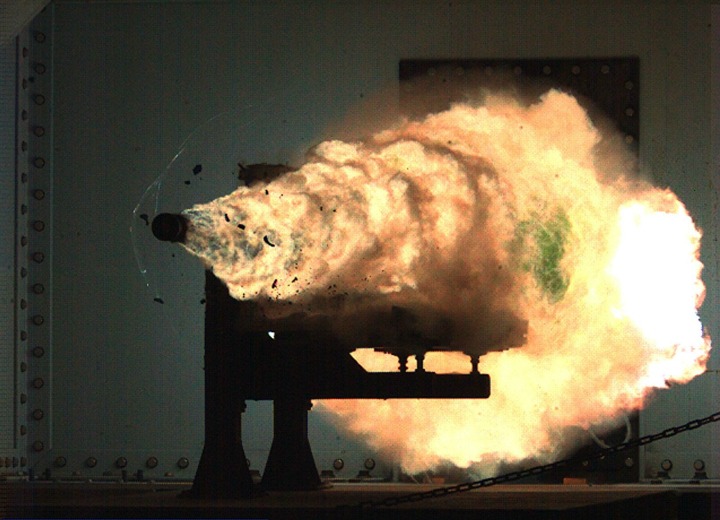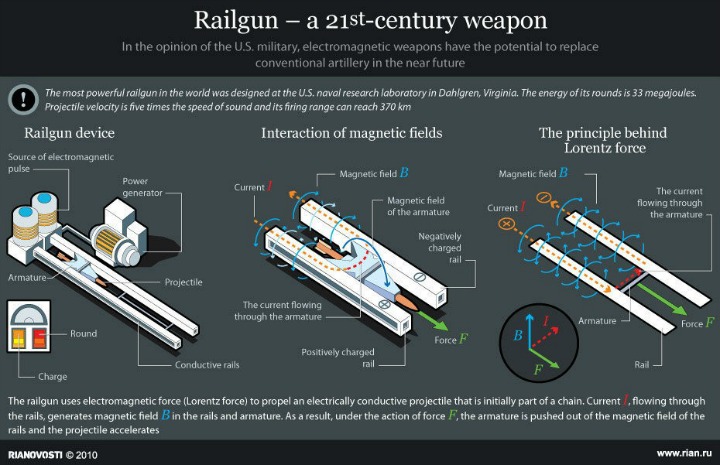The Railgun: What You Need to Know About America’s Groundbreaking New Weapon

Author: US Navy, License: Public Domain
If someone asks you to close your eyes and picture the battlefield of the future, you will probably see soldiers, vehicles and maybe even robots firing energy based weapons. It’s what anyone who has seen or read any work of science fiction will imagine; weapons that can be fired without the aid of combusting chemical propellants. No loud bang, no clanking shells, and no smell of napalm in the morning; just a zap or a zoom and a perfectly placed and conveniently cauterized blast point.
As some of you might already know, humanity is currently taking the first baby steps into that direction. Since the turn of the century, several military and private organizations have designed and developed directed-energy weapons (DEW). As the name implies, these weapons work by directing concentrated energy such as microwave or infrared to a target. Existing weapons systems that use this concept include the US military’s non-lethal Active Denial System (ADS) and Lockheed Martin’s Laser Weapons Systems.
However, the first practical use of energy-based weaponry that the world will remember will come from a slightly different direction. Instead of directly firing concentrated energy into the enemy, the US Navy is currently testing and will soon be deploying a system that uses electromagnetism to propel projectiles. Without the use of chemical propellants, the railgun promises a cheaper, more efficient and even deadlier alternative to conventional field and naval artillery.
How does a railgun work?

File:3MpUJGm.jpg owned by CarpetSharx7. Licensed under CC BY-SA 4.0
A railgun is made of three main parts. The first is a power source. The second are 2 parallel conductive metal rails, (hence the name) one positively charged and one negatively charged. Lastly, you’ll need a projectile that also conducts electricity.
The conductive projectile is placed between the two rails, forming a circuit. Basically, current passes from one rail across the projectile and onto the other rail, generating electromagnetic fields along the way. Because the rails are oppositely charged, their electromagnetic fields spin in opposite directions. This phenomenon creates a force that accelerates the projectile forward and away from the power source.
The projectile is composed of a solid non-explosive bullet encased in an aluminum frame called a sabot, which falls away upon leaving the rails. Recorded at around six times the speed of sound (Mach 6), the sheer speed of the projectile accounts for its destructive power, eliminating the need for explosives. Think of how a small meteor can make a huge crater and you’ll get the idea.
Military Applications
The US military sees great potential in the railgun technology. Since the early 2000’s they have funded its development. According to the Walls Street Journal, the Pentagon’s Strategic Capabilities Office signed off on an additional 800 million dollar funding to develop the weapon’s defensive capability.
The railgun is expected to replace the US Navy’s explosive-propelled cannons. Currently, only the Zumwalt-class destroyer can generate the energy required to power the weapon.
The rise of aircraft carrier-based warfare during the Cold War pretty much eliminated the need big naval cannons. The introduction of the railgun can usher in a resurgence of cannon wielding battleships like the ones that became legend during the Second World War.
Advantages
The railgun is better than current missiles and explosive projectiles in many ways. Probably the most appealing is the low cost of operation. A single round fired by a railgun is estimated to cost somewhere between 25000 to 50000 dollars. In comparison, a Tomahawk cruise missile costs more than a million dollars.
Another selling point is safety. Because the railgun operates without chemical propulsion, ship will not have to carry large amounts of explosives the form of shells and missiles which can go off accidentally or when the ship gets hit by the enemy.
Railgun projectiles also take up less space. A ship equipped with rail guns can theoretically carry a thousand rounds. Overall, the railgun will open a new era in military technology.
Challenges
Like all new technologies, the development of the railgun faces some hurdles. One of the main obstacles so far is the huge power requirement. The railgun needs 25 megawatts to fire, which is enough to power about 19,000 homes. Furthermore only 3 Zumwalt-class destroyers, the only ships that can generate that much power, will be produced.
According to Popular Mechanics, the biggest problem is that the railgun gets worn out real quick. Basically, the great amounts of energy produced by the weapon tears away parts of the internal mechanism with every use. The contact between the sabot and the rails alone erodes the gun.